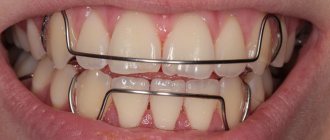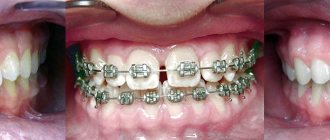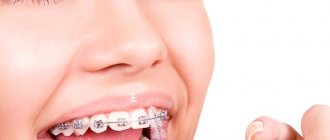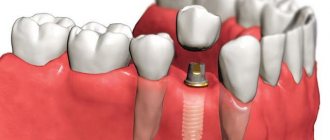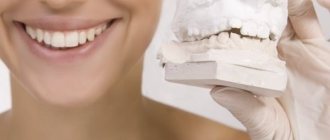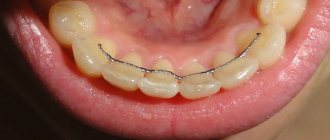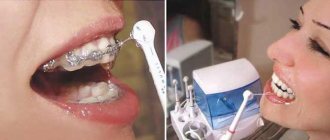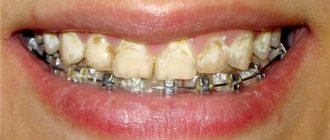Aligners VS Braces
Make an appointment
online
Request a call back
Andrey Vladimirovich, most people imagine aligners as transparent mouthguards like sports ones. What is the difference between aligners and aligners?
Aligners are a technique for correcting malocclusion using aligners. But mouthguards are different. Aligners are made using 3D modeling and 3D printing, and each aligner (aligner) is programmed to move teeth. Simple mouth guards - no. Therefore, if we are talking about the movement of teeth, then these are aligners; if we are talking about mouth guards for other purposes (sports, whitening, for bruxism, etc.), then these are just mouth guards.
Are these mouthguards made in special laboratories?
Clinics that do not have their own dental laboratories order their production. Our clinic has a device that allows us to make retention (to hold teeth after orthodontic treatment) and sports mouth guards. This allows the patient not to wait 5 days for the mouthguard to be made and delivered - because during this time, without retention, the teeth can shift.
Are there any contraindications to installing aligners?
Contraindications are the same as for installing braces: severe periodontitis, poor oral hygiene, poor condition of bone tissue, ankylosis (damaged dental apparatus), uncompensated endocrine diseases. Special rare cases, such as metal allergies.
Nowadays, many manufacturers produce aligners. Which ones do you use in your practice?
In the installation of aligners, the lion's share of effectiveness is provided by the program according to which the movement of the teeth is planned. In second place is the work of the technicians and, of course, the materials used. Previously, we used more aligners from Invisalign. This company was the first to deal with the topic of aligners about 20 years ago. At that time, the topic of 3D printers was not so widespread and Invisalign were the first to master this technology. But times are changing and a huge number of manufacturing companies are appearing with new ideas and solutions.
To work in this profile, must a doctor undergo training and buy a machine for making aligners?
Simply completing the training is enough. A certified physician gains access to the program. Although there is an option when you can buy the program and your own 3D printer.
What are the advantages of aligners compared to braces?
The one and main advantage is that they are invisible. The mouthguards are naturally removable. But the fact that they can be removed is both an advantage and a disadvantage. If you do not wear a mouth guard 22-24 hours a day, there will be no result. Therefore, the responsibility falls on the patient. Since the aligner develops pressure on the teeth, removing and installing it is not a very pleasant procedure. But they need to be taken off and put on before eating, before drinking hot drinks, and naturally, some patients do not wear them properly.
After installing braces, you also feel discomfort from compressed ligaments and pressure on your teeth, but only in the first days. And with aligners, after each removal the ligaments stretch, then you put them on - they shrink. And this discomfort is repeated every day. After a break, putting on a mouth guard can be painful.
It's like with children's records. Many people wore them as children. But the result was achieved only by the most pedantic. Others simply took them off and forgot to wear them regularly.
Then let's talk about children. Does it make sense to put aligners on them?
If you have extra money (aligners are more expensive than braces) and your child is very disciplined, then you can. But usually the child does not need this: he does not have official meetings or business negotiations. Why strive for the invisibility of orthodontic appliances? Let him wear braces.
It turns out that it is advisable to install aligners only for adults?
Yes. But even an adult must sensibly assess his capabilities and be psychologically ready to do this. It's like with retainers. They are removable and non-removable. Someone is afraid of losing or forgetting - this is how we stick on a retainer. And someone is ready to be neat and pedantic - they wear removable ones.
What is the disadvantage of aligners?
Will explain. We are 3D printing a “path” from crooked teeth to a correct bite. And this path consists of steps. Each step is a new aligner. With braces, if something doesn’t go according to plan, you can change the bend, give another traction, or rearrange it. And with aligners, the plan is clearly written, the field of possibilities is narrower, we follow the plan as if on rails.
Does this clearly developed plan provide a 100% guarantee of correcting the bite?
Sometimes you can come across patient complaints that these aligners crack.
Yes. And then you need to order a new one. If you ordered American aligners, make allowances for the delivery time - they will take two weeks. During this time, the teeth will move away from the result already achieved. Braces are more reliable in this regard. In the hands of a skilled specialist, they show the best results.
Are the pain levels comparable when installing aligners and braces?
When installed, they are comparable. Another thing is that these sensations go away later with braces. And with aligners, after each removal, you tighten and stretch the ligaments again.
When should they be removed?
The aligners should be removed when eating. Otherwise, they may crack from hard food, and then you will have to order new ones.
What is easier to get used to: braces or aligners?
In my opinion, to braces. It takes 2 weeks to get used to it. After this, the patient stops noticing them. It is also necessary to note this point: when installing aligners, special attachments are glued to the teeth. It turns out that you actually have a brace glued to each tooth.
What corrects a bite faster: aligners or braces? With the note that in both cases (both on aligners and braces) an experienced specialist works?
It depends on the case. For example, aligners will correct mild crowding of teeth in 4 months, braces - in 3 months. And if serious correction of the bite is required, then the time required for the aligners will be very long and this treatment will no longer be adequate.
Indications for use
Mouth guards and braces are similar in purpose, but have significant design differences. To find out what function each system performs, it is worth studying the indications for their use. Mouth guards are devices made of silicone material that apply gradual pressure to the teeth. It is installed in the following cases:
- deep bite;
- uneven teeth;
- small gaps between molars;
- securing teeth after wearing braces.
On this topic
Choosing the best brush for cleaning braces
- Maria Konstantinovna Tevs
- October 5, 2020
The latter indication is a unique combination of two types of treatment with these systems. Braces are used when the patient has:
- deep malocclusion ;
- disproportion ;
- crooked teeth;
- grouping of molars in the oral cavity;
- interdental spaces.
The braces are represented by a metal arch with ideally shaped locks. Wearing the system is designed to consistently align and extend individual teeth, as well as change their position. Based on the listed indications, we can conclude that mouthguards are ideal for minor defects, while braces are suitable for guaranteed bite correction.
Children and adults
Depending on the age of the person, the relevance of installing one of the treatment systems is determined. Trainers - mouth guards - are well suited for children when the jaw is just developing and is in a mobile state. The only nuance that arises during installation is the child’s understanding of what the system is needed for. It is recommended to start treatment in children from 6 years of age.
On this topic
How to use wax for braces
- Maria Konstantinovna Tevs
- October 5, 2020
for adults , but they will work differently. Due to the fact that the jaw has long been formed, mouth guards are suitable as a fixing element after treatment with braces. The latter are used at any age, but you must be prepared for the fact that the timing of teeth straightening will increase.
It is relevant to install braces for children over 11 years of age. If wearing a metal structure was started much later, the treatment period is extended. Braces form the position of the dentition, which is an important process in the formation of the jaw, and mouth guards are positioned as a means of preserving the result.
Advantages and disadvantages of removable aligners
Caps have many advantages:
- unlike fixed structures, they can be worn for a limited time;
- using mouthguards after braces is more comfortable, since the jaw “rests” from metal structures;
- Oral care is easier if the retainer can be removed.
The main disadvantage of aligners is that they are a noticeable design that affects appearance, so not everyone is ready to wear such retainers during the day. In addition, the design can cause increased salivation.
Aesthetics
If we compare the two selected systems in terms of attractive appearance, then braces are significantly inferior to aligners. However, one should not make hasty conclusions: today orthodontists offer to install metal structures that are not visible during communication. These are sapphire, ceramic or lingual braces that are fixed to the inside of the teeth.
Thanks to the transparent silicone material, the mouthguards are almost invisible when speaking. This treatment option is suitable for patients experiencing discomfort due to wearing the system. Recently, it has become fashionable to express yourself and distinguish yourself from the people around you. Therefore, teenagers willingly agree to the installation of visible metal braces, thereby expressing their individuality.
How to create a perfectly straight smile: braces or aligners, which is better?
The use of braces or aligners (aligners) for the treatment of dentofacial anomalies is one of the methods used in orthodontics.
The main goal is to correct malocclusion, crooked or uneven teeth , as well as other dental problems. Treatment with braces involves installing a fixing metal structure along the trajectory of the dentition, and mouthguards are a device made of polyurethane or silicone, which is transparent and not visible on the teeth.
Both options may be suitable for effective teeth straightening.
Mouth guards after braces - price
Prices for mouth guards after braces are removed, as well as for other orthodontic services, largely depend on the level of dentistry in Moscow, quality and type. When paying for treatment with a braces system as a set, turnkey, mouthguards are included in the price. This should be discussed in advance during your visit to the orthodontist. If the patient paid for all procedures separately, then the price for mouth guards will be from 5,000 rubles. This is not the most expensive part of treatment with braces.
Retention trays are very convenient for consolidating the success of orthodontic treatment. If the patient fulfills all the doctor’s requirements and wears the device for the required amount of time, the result achieved in the process of correcting the bite will remain forever. Be sure to wear mouthguards after braces - and straight teeth will be a source of pride.
Indications for use of caps
They include a narrow list of indications. Mouth guards can be used instead of braces for patients with malocclusion, misaligned teeth , which can complicate biting and chewing, and also cause aesthetic discomfort .
The main indications for installing mouthguards instead of braces:
- The presence of diastemas and three or clefts between the teeth.
- Installation before implantation if there is not enough space in the dentition .
- Increased torsion of teeth (more than 6 mm).
- Pathological tilting or rotation of teeth.
- Cross, distal, mesial and open bites.
Reference! Mouthguards are prescribed not as the main therapy, but as an additional support measure after wearing braces for a long time.
This technology is not suitable in cases where canines or premolars are rotated, with bridge prosthetics and posterior bite pathology . Mouthguards are also less commonly used for vertically tilted or twisted teeth.
Characteristics of staples and braces
Braces are a whole complex of devices that are fastened together and function smoothly. They are attached to the teeth using special cement. Thanks to him, it is possible to obtain reliable tenacity for a long time. Thus, braces are non-removable metal structures.
Braces are a single system that is attached to a tooth and encircles it. In addition, the staples may not be secured at all. This type of structure is a non-removable model, and its functioning occurs with various pathologies of the jaw. However, it also has its drawbacks - bulkiness and inconvenience.
Depending on the materials, braces or staples are divided into the following types:
- Metal braces. This option of dental products is the most common. This popularity is due to their high reliability and low cost. Metal products are the easiest to maintain and the most effective. Their disadvantage is their unattractive aesthetic appearance.
- Plastic braces. They are characterized by great aesthetics. With the right color selection, you can choose a plastic structure that perfectly matches the shade of the enamel. The disadvantages of plastic include low reliability, susceptibility to staining, and the need for increased attention and care.
- Ceramic braces. They are ways to camouflage themselves with the color of tooth enamel, like plastic. At the same time, ceramics is not a durable material, although it is relatively fragile.
- Sapphire braces. To obtain them, durable and transparent sapphire obtained artificially is used.
The following classification divides staples and braces into the following types:
- Vestibular (external). They are attached to the outside of the teeth.
- Lingual (internal). Such installations are attached to the lingual side of the teeth, so they are completely invisible. The material used for manufacturing is metal. The duration of wear is not that long, because the material is able to exert a certain pressure on the teeth.
According to the adjustment method, staples and braces are divided into the following types:
- Ligatures. They are fastened using rubber bands. These types of structures must be constantly changed and manual adjustment of the arc pressure on the dentition must be performed.
- Self-ligating. In such products, the arc does not have a rigid fastener to the clasps; it can only slide into them, selecting the necessary pressure taking into account the position of a particular tooth.
Indications for treatment with braces
In addition to malocclusion pathologies, there are a number of diseases of deep etiology, where other methods cannot be used. As a rule, these products are indicated for significant deformations that require the use of non-removable systems.
- Severe crowding or thickening of the dentition, which is usually characterized by exposure of the tooth root.
- Defects of jaw development.
- Restoring the density of teeth when they are located at a significant distance throughout the entire row.
- Complex forms of malocclusion pathology , for example, deep bite or dystopia.
Reference! At the moment, there are braces of a wide variety and shapes. For example, it is possible to install a lingual structure that fixes the dentition from the inside , making it invisible. They also use a wide range of materials for manufacturing: from classic metal to different types of ceramics.
What is the difference between mouth guards and braces?
Therapy using aligners is presented as a progressive method of correcting malocclusion, but is characterized by high cost and limited indications for use.
The principle is to install a transparent overlay on the teeth , consisting of hard polymers, which makes it invisible. Of course, what is important for the patient is how mouth guards differ from braces – transparency and relative invisibility.
However, mouthguards still do not solve serious dental problems that are corrected by installing braces.
Each method has advantages and disadvantages , and choosing the appropriate one occurs by achieving a balance between effective elimination of the disease and wearing comfort.
Pros and cons of aligners
When choosing a bite correction method, you need to learn in detail about all the pros and cons of installing mouth guards. The main advantages and disadvantages of aligners are listed below.
Advantages
- Highly aesthetic , as they are invisible.
- Comprehensive and simultaneous correction due to the full circumference of the crown.
- They do not impair diction or interfere with conversation.
- Individual approach during installation.
- Simplified oral hygiene.
- Does not injure mucous membranes and gums.
- Doesn't wear off enamel.
- Hypoallergenic.
- A quick appointment with a doctor is suggested.
- There is no risk of developing caries.
Photo 1. Aligners for teeth correction. The main advantage of mouthguards is their invisibility and aesthetics.
Flaws
- High price.
- Not available to children.
- Narrow scope , since they do not treat serious pathologies.
- Long production time.
- Risk of loss.
- High maintenance requirements.
- Long-term treatment.
Features of wearing mouth guards after braces
After removing braces, mouth guards can be made individually for the patient, but this is not necessary. In some cases, standard models are also used. Typically, mouthguards are made from biopolymers that are absolutely hypoallergenic. They do not injure the mucous membranes of the oral cavity and practically do not cause discomfort and do not interfere with eating. The patient does not have to worry about how to put on mouth guards after braces - this does not require special skills; anyone can handle this operation on their own. Questions about how to wear a mouthguard after braces usually do not arise.
However, wearing a mouthguard after braces is still a full-fledged period of treatment, and it has its drawbacks. Among them:
- provoking active salivation - hypersalivation;
- some problems with the pronunciation of certain sounds;
- frequent visits to the orthodontist.
Despite these small problems, the question is: “Do I need to wear aligners after braces?” – should not arise. The answer to this is clear - a mouth guard must be used after braces for the above reasons.
Pros and cons of braces
Undoubtedly, many years of experience in using braces confirms the high success of dental correction. But as with everything, braces have their pros and cons.
Advantages
- High efficiency , which is achieved due to the action of the reinforcing structure.
- Extended scope.
- They are under the supervision of a doctor , which eliminates the possibility of complications due to the patient’s incorrect actions.
- Relatively low cost.
Flaws
- Aesthetic discomfort.
- Long installation.
- Non-simultaneous restoration of the dentition , where each tooth is corrected separately.
- Possible consequences in the form of abrasion and staining of the enamel .
- Injury to the mucous membrane.
- Deterioration of diction.
- Risk of caries development.
Features of treatment with aligners
Manufacturing a suitable set of trays takes about two months, which indicates the high quality of the system. The duration of therapy varies from 9 months to 2 years , however, it is determined individually.
After the main treatment, the patient is provided with additional supporting structures designed to improve the result, which slightly increases the duration of therapy. The duration of treatment does not become a noticeable disadvantage, since the mouth guards are comfortable to wear and do not cause significant discomfort.
The cost of treatment will depend on the nature of the illness, the duration of therapy and the policy of the institution. The price of one mouthguard fluctuates around 8-15 thousand rubles . During treatment, the aligners are replaced 15-20 times . The full cost of therapy, including three-dimensional design, consultation with a qualified doctor, installation and manufacturing, costs 100-200 thousand rubles .
Important! If you do not follow the doctor’s instructions or wear mouth guards less than prescribed, the duration of therapy will increase.
The price will also depend on the number of trays in the set. In mild cases, a set of 15-20 drops is enough ; in advanced cases, additional ones may be required, which will definitely affect the price. This is largely why it is important to see a doctor on time . Each dental clinic prescribes its own conditions and procedures for treatment, and also sets markups based on the internal policy of the institution.
How long to wear mouthguards after braces?
Recommendations on how long to wear mouth guards after braces can only be provided by your attending physician. Typically, the orthodontist develops a plan for how long mouth guards need to be worn after braces, which helps maintain the correct bite and minimizes possible discomfort for the patient. The doctor will indicate the approximate duration of the retention period.
Immediately after the braces are removed, the patient is usually advised to wear the aligners for a fairly long period of time every day. Most likely, you will have to wear them at night. Gradually, the time of wearing the aligners decreases: after a year, removable structures will need to be worn only once or twice a week. Typically, the timing of the entire “fixing” period is influenced by factors such as:
- type of malocclusion;
- position of teeth before treatment;
- presence of smoking addiction;
- number of teeth removed (according to indications).
Also, the retention period increases if the patient is over 30 years old. Age has a strong influence on the success of malocclusion treatment and on how long you need to wear a mouthguard after removing braces.
Recommendations for caring for mouthguards
If you follow the recommendations, the mouth guards will serve the required time, will not aggravate the disease, and will fully justify the cost. Here are some tips for caring for your mouth guards:
- Wear for at least 22 hours a day and remove only when eating or brushing your teeth.
- Brush the outside with a toothbrush and toothpaste , rinsing with cool water, morning and evening.
- Rinse with water after every meal.
- For cleaning , choose toothbrushes with soft bristles.
- Keep in special protective containers.
Important! It is necessary to strictly adhere to the doctor's recommendations, otherwise therapy may be unproductive or expensive.
Why do you need a mouthguard after braces?
After removing the braces, the patient faces a retention period, which consists of wearing retainers after braces or mouthguards. These are fixed and removable structures, respectively. Retainers are a metal bracket that holds teeth in the desired position. They are installed by a doctor and are not removed during treatment. Mouthguards are removable structures that the patient wears for a certain number of hours a day. They should not be confused with a mouthguard for correcting bites, which is used independently and is an alternative to the braces system. There are also sports mouth guards for braces that protect teeth during traumatic physical activity, but they differ significantly from retention mouth guards.
Mouthguards after braces are removed are necessary to consolidate the success achieved. Many patients, after many months of wearing braces, do not want to put on another orthodontic device, do not understand why a mouth guard is needed after braces, and stop treatment. In this case, the achieved result will be lost. Refusal to wear dental trays after braces will most likely cause the teeth to return to the wrong position, and all the positive effects will be lost. Then the long period of treatment, the money spent and the time spent on straightening the teeth will be in vain. Every patient should understand why they need to wear a mouth guard after braces.
An orthodontic mouthguard after braces will not cause excessive discomfort. This fairly lightweight and discreet device ensures that teeth are held in their new position. An additional function of mouthguards is protection - they protect teeth from mechanical stress.
What is better: braces or mouthguards
Braces are the most common type of orthodontic structures that can solve almost any curvature of the teeth and bite.
Aligners are an alternative to braces that appeared about 15 years ago. Mouth guards are elastic, colorless caps that are fixed to the entire dentition.
Both types of structures are actively used today to correct bites, but which of them are more effective, more affordable and do not cause discomfort?
This is interesting! According to research, in the modern world, most employers perceive those with braces or aligners as individuals who strive for excellence, are proactive, and know how to work on a problem and on themselves. The growing level of service obliges people working not only in public, but also in sales to smile, and if due to dental problems in 2005 only 49% of the staff did this, then in 2020 about 86% of people greet and see off customers with a smile. Demand creates supply, which is why orthodontics is so in demand 1.
Correction of bite with internal braces Win – 180,000 rub.
All inclusive! Preparation and treatment of the oral cavity, consultation with an orthodontic specialist, installation and adjustment of orthodontic structures. The price is for one jaw.
Free consultation with an orthodontist +7 (495) 789-39-31 or write to us
Braces or aligners: which is better?
| Braces | Mouth guards | |
| Indications for use | Allows you to correct almost any dental defect: severe crowding, twisted or rotated teeth | Used only for minor tooth curvatures |
| Children or adults | For both children and adults | Children can also wear them, but since the aligners are easily removable, it will be difficult to monitor their constant use by the child |
| Aesthetics | Depending on the chosen models: metal ones are not aesthetically pleasing, those made of ceramics, sapphires or lingual braces are little or not noticeable on the teeth | Very high: the aligners are translucent and almost invisible on the teeth |
| Comfort | It takes a long time to get used to: no matter how comfortable braces are, you will have to get used to them. Metal structures can cause inflammation of soft mucous membranes and even invisible lingual systems lead to severe speech distortion | Maximum comfort: the mouth guards are soft and do not rub the mucous membranes. But the teeth increase in size, so it takes getting used to the foreign body in the mouth |
| Hygienic care | Difficult: at least 10 minutes are required for each cleaning of braces. It is necessary to purchase a large number of hygiene products | Very simple: the aligners are removed when eating or brushing your teeth. They must be cleaned with water and brushed with a special soft toothbrush. The teeth themselves require more care |
| Diet | You cannot chew nuts, hard, sticky and viscous foods, vegetables and fruits must be cut first | You can eat anything: the mouth guards must be removed when eating |
| Time frame for bite correction | On average 1-1.5 years | On average 8-10 months |
| Effect after treatment | Lasts for a long time if the retention period is observed | Longer lasting than when corrected with braces. But compliance with the retention period is also required. Mouthguards must be promptly replaced with new ones - and there can be up to 40 of them in a set |
| Cost of treatment | From 20 thousand rubles for 1 jaw | From 100 thousand rubles for one jaw |
Braces are more effective at treating almost any type of malocclusion.
At the same time, they are noticeable on the teeth (if we are talking about the vestibular systems), and quite often cause severe discomfort, rubbing of soft mucous membranes with hard edges and a metal arch. After braces, some complications are possible: damage, darkening or chipping of the enamel, inflammation of the gums, pain, allergic reactions, tooth mobility. However, braces cannot be removed independently - and this is an important aspect in children's treatment, since a child may not wear aligners without supervision. Mouthguards are designed to correct minor malocclusions. On average, the duration of treatment is the same as the time required to wear braces. But the mouthguards are softer, more elastic and comfortable, and do not cause discomfort.
EXPERT OPINION
Indeed, uncontrolled removal of aligners by children can disrupt the course of treatment and it will be completely ineffective.
There is another undoubted advantage of orthodontic aligners - they can be used simultaneously as a whitening and enamel-restoring agent; to do this, it is enough to place a special gel or medication inside the cap.
Material of manufacture
Modern manufacturers make mouth guards as invisible and thin as possible so that they are unnoticeable on the teeth, because you need to wear them all day. Most often, silicone and polyurethane are used in production, which meet all the necessary requirements. Depending on the selected material, the price of the product changes.
Silicone mouth guards are not particularly comfortable to wear constantly, as they are quite massive. If you look at the picture of the silicone pad, it will look white and have thick walls. In addition, the patient may feel it on his teeth, which can cause some discomfort. Typically, silicone pads are worn before bed and are not intended for 24-hour use. They can also be worn for 2-3 hours during the day, however, provided that the patient does not talk or eat during this time. The main purpose of the design is to consolidate the results after braces.
Their polyurethane mouth guards are lighter, thinner and more transparent. They do not cause any discomfort during prolonged wear, and also do not impair diction. Typically, polyurethane models are prescribed when it is necessary to correct minor defects and crooked teeth. This pad can be worn throughout the day, only being removed when eating.

